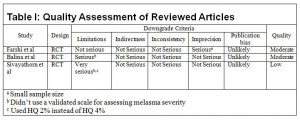Azelaic Acid is an Effective and Safer Alternative to Hydroquinone in Treating Mild to Moderate Melasma in Women
ABSTRACT
Background: Hydroquinone has been the gold standard in treating melasma, but it does not come without possible adverse events, which include leukoderma and ochronosis, both of which may be irreversible. Furthermore, hydroquinone has been banned in Europe and Asia due to adverse events and toxicity. Azelaic acid may be an alternative to hydroquinone and boasts not only skin lightening properties but bacteriostatic, keratinolytic, and antioxidant capacities as well. Can azelaic acid be a safer option with comparable efficacy in the treatment of melasma?
Methods: An exhaustive search of available medical literature was conducted using MEDLINE-Ovid, CINAHL, Web of Science, and International Pharmaceutical Abstracts using the keywords: hydroquinone, dicarboxylic acids, azelaic acid, melanosis, melasma, melanosis drug therapy, and dermatologic agents/therapeutic use. Articles which met the clinical question and inclusion criteria of studies evaluating human participants and articles written in the English language were evaluated for quality using Grading of Recommendations, Assessment, Development and Evaluation (GRADE).
Results: Three articles met eligibility criteria. In all three articles, azelaic acid was found to be at least as effective as hydroquinone. Two studies were double-blinded and one was an open label trial where the evaluators were blinded. The two double-blinded studies had a large sample size of over 300 patients, whereas in the open label clinical trial the authors noted some limitations in that there was a small sample size of 29 patients. Overall, the quality of the studies was moderate to low due to limitations.
Conclusion: The studies suggest that azelaic acid applied twice daily along with a broad spectrum sunscreen is as effective with less chance of adverse side effects than hydroquinone therapy for the treatment of melasma.
Keywords: Hydroquinone, dicarboxylic acids, azelaic acid, melanosis, melasma, melanosis drug therapy, and dermatologic agents/therapeutic use.
(Click on image to enlarge.)
REVIEWED STUDIES:
Farshi S. Comparative study of therapeutic effects of 20% azelaic acid and hydroquinone 4% cream in the treatment of melasma. J cosmet derm. 2011;10(4):282-287.
Balina LM, Graupe K. The treatment of melasma: 20% azelaic acid versus 4% hydroquinone cream [abstract no:2]. Indian Journal of Dermatology, Venerology and Leprology. 1992;58:66.
Sivayathorn A, VeralloRowell V, Graupe K. 20% azelaic acid cream in the topical treatment of melasma: A double-blind comparison with 2% hydroquinone. European journal of dermatology. 1995;5(8):680-684.
AUTHOR: Elizabeth Schmidt is currently completing her second year in the School of PA Studies at Pacific University, Oregon. She will graduate with an MS in Physician Assistant Studies in August, 2016.

